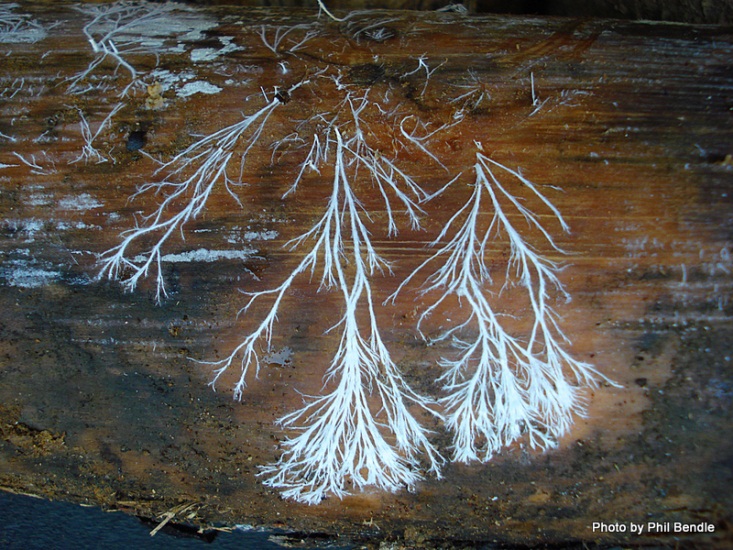Nutrition
I am sad to inform you that there is little known about the specific diet of Millerelix peregrina. Instead, we will focus on the diet of the larger group of air-breathing land snails, also known as the terrestrial pulmonates mentioned in the previous adaptation section within which Millerelix peregrina is included.
Terrestrial pulmonates are mostly herbivores and omnivores, but very few
feed on other animals (Hickman et al., 2012). They can
feed on a wide variety of material including algae, fungi, soil, and plant
matter (Pennsylvania Land Snails, 2012). The main course for the Family Polygyridae, which includes the species
Millerelix peregrina, is the
mycelia of fungi, shown on the right (Pilsbry, 1940).
Mycelia are known to be the collections of thread-like branching portions of
a fungus (Wikipedia, 2012).
 Because this group’s main
food source is fungus, their eating habits are commonly referred to as fungivory
or mycophagy, which simply means that they consume fungi
(Wikipedia, 2012). Since these animals are
susceptible to water loss, they tend to search for food at night or when it
rains (Pennsylvania Land Snails, 2012). As explained earlier in the adaptation portion of
this webpage, these gastropods use a rasping organ, called a radula, to
grind and scrap food into their mouths (Hickman et al., 2012). When food
enters the mouth, saliva immediately begins to break down the ingested
substances
(Pennsylvania Land Snails, 2012). The food is moved downward by multiple muscles through the
esophagus and into the gastric pouch, where fluids continue to digest the
sustenance (Pennsylvania Land Snails, 2012). Next, an organ called the digestive gland,
similar to a liver, helps the animal absorb nutrients from the fungi or
plant material, while also serving to dispose of wastes and control body
chemistry (Pennsylvania Land Snails, 2012).
After taking a detour in the gastric pouch, the food (now wastes), move along the intestines to the rectum to be expelled,
thus completing the process of acquiring nutrition (Pennsylvania
Land Snails, 2012). But how do pollutants in an environment affect a
snail? If you keep reading you will get an answer to this question.
Because this group’s main
food source is fungus, their eating habits are commonly referred to as fungivory
or mycophagy, which simply means that they consume fungi
(Wikipedia, 2012). Since these animals are
susceptible to water loss, they tend to search for food at night or when it
rains (Pennsylvania Land Snails, 2012). As explained earlier in the adaptation portion of
this webpage, these gastropods use a rasping organ, called a radula, to
grind and scrap food into their mouths (Hickman et al., 2012). When food
enters the mouth, saliva immediately begins to break down the ingested
substances
(Pennsylvania Land Snails, 2012). The food is moved downward by multiple muscles through the
esophagus and into the gastric pouch, where fluids continue to digest the
sustenance (Pennsylvania Land Snails, 2012). Next, an organ called the digestive gland,
similar to a liver, helps the animal absorb nutrients from the fungi or
plant material, while also serving to dispose of wastes and control body
chemistry (Pennsylvania Land Snails, 2012).
After taking a detour in the gastric pouch, the food (now wastes), move along the intestines to the rectum to be expelled,
thus completing the process of acquiring nutrition (Pennsylvania
Land Snails, 2012). But how do pollutants in an environment affect a
snail? If you keep reading you will get an answer to this question.
Pulmonates that reside on land can serve as reservoirs for pollutants, which give scientists an educated idea of how much toxic waste is being dumped into an area (Pennsylvania Land Snails, 2012). A study done by Reinhard R. Dallinger of the Institute of Zoology, at the University of Innsbruck, along with other researchers, observed the levels of cadmium obtained in a land snail’s tissues based on the environment it was put in (2004). One of the sites the snail was placed in had high levels of cadmium in the soil, while the other location was an unpolluted site and served as a control setting (Dallinger et al., 2004). The results of the study confirmed that the land pulmonates that resided in environments with greater pollutants had a greater concentration of that toxic metal in their bodies than did the snails from the untainted area (Dallinger et al., 2004). Overall, this study suggests that terrestrial snails can serve as biomarkers for pollutant accumulation in an environment (Dallinger et al., 2004).
To learn more about these fascinating organisms and how they reproduce click reproduction!
back to Home Page